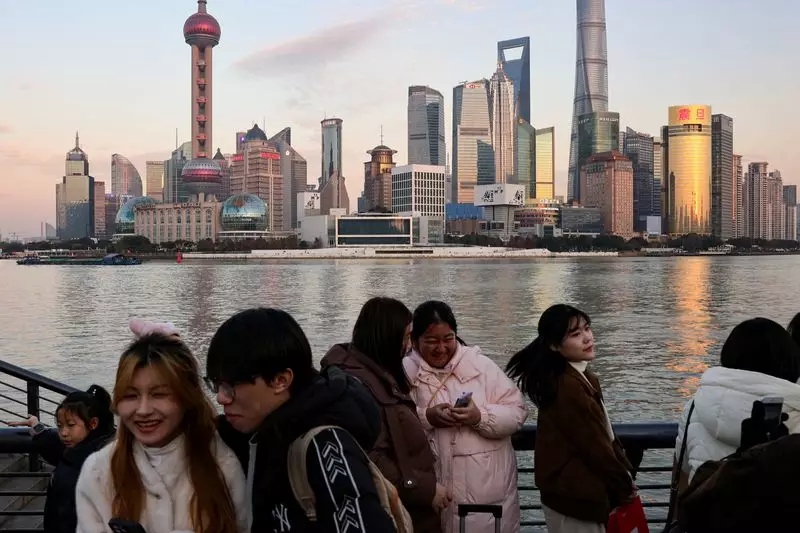China’s economy has consistently been the focal point of global attention due to its vast scale and intricate dynamics. Recently, reports indicated that the nation achieved a growth rate of 5% for the previous year, aligning with governmental targets. However, this growth story has deeper layers that warrant scrutiny, particularly given the public’s sentiment and the underlying structural issues conspiring against widespread economic well-being.
While achieving a growth rate that meets official targets might seem commendable, the reality is fraught with complexities. The figure of 5% masks a troubling disparity between industrial performance and real consumer growth. Evidence suggests that many citizens are experiencing stagnant or declining living standards, leading analysts to question whether the reported successes genuinely reflect the experiences of the average citizen. With industrial output surging ahead of retail sales, it becomes evident that the engines driving growth are misaligned with domestic consumption, raising alarms about sustainability and long-term viability.
The skew in economic progress is alarming, given that the added momentum comes while unemployment rates creep upward. Despite China boasting a trillion-dollar trade surplus, the benefits have not trickled down effectively. This symptom of economic imbalance could indicate deeper-seated issues within the consumption sector, suggesting that stakeholders—including private individuals and corporations—are not reaping benefits commensurate with industrial successes.
China’s economy has traditionally relied on export-led growth. This approach is bolstered by favorable factory gate prices that enhance the competitiveness of Chinese goods globally. However, this situation is precarious; as trade conflicts intensify, increasingly reliance on exports can backfire, leaving the economy vulnerable to external shocks. Falling prices, while promoting competitiveness abroad, are simultaneously inducing corporate losses and diminishing employee wages domestically.
Andrew Wang, an executive in the industrial automation field, exemplifies the dissonance between official economic statistics and lived experiences. His company faced a significant 16% revenue drop, leading to layoffs, suggesting that the so-called growth is accompanied by bitter realities on the ground. The juxtaposition of reported economic data with personal anecdotes highlights essential gaps, posing critical questions about the actual health of the economy.
As the Chinese government considers avenues for stimulus funding, concerns abound that a focus on industrial upgrades and infrastructure may exacerbate overcapacity in factories, further weakening domestic consumption. Analysts argue for a shift in policy emphasis toward household support, encompassing broader fiscal reforms, and addressing debts accrued by local governments amid economic turbulence. Without intervention, the ongoing focus on industrial prowess over consumer strength might lead to stagnation, increasing the vulnerability of the economy to external pressures, particularly from ongoing global trade tensions.
Additionally, there are indications from financial experts that even if growth is reported at a stable rate, this presents a façade, concealing deeper issues rooted in consumer demand within the economy. The broader implications of such domestic deficiencies could amplify global trade tensions, as exhibited by the rise in tariffs projected by the U.S. government.
In the face of recent revealings about the economic landscape, consumer and job market sentiments are shaken. Young professionals, like investment banker Jiaqi Zhang, embody the unease prevalent across various sectors—salary cuts and job losses paint a grim picture. Zhang’s experience is a microcosm of broader fears about job security and economic stability, eliciting a cautious approach to spending that could stifle growth further.
Furthermore, the reported economic indicators of resilience are undermined by the tone of consumer behavior. As individuals like Zhang restrict their spending on luxuries, such an approach could contribute to an economic cycle that hinders recovery, rendering the vibrancy of market growth elusive.
While China’s economic growth figures present a polished picture, they mask deeper structural issues that need to be confronted. Skepticism regarding the authenticity of reported data continues to grow, necessitating a more nuanced understanding of the drivers behind the metrics. Analysts argue that sustaining growth requires rebalancing efforts focused on boosting domestic consumption, addressing talent flow amid emerging structural changes, and anticipating the challenges posed by an increasingly hostile global environment. The economic narrative surrounding China is multifaceted, as the nation grapples with redefining its growth strategy to ensure a more inclusive and stable economic future for all its citizens.

